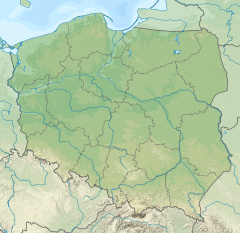
Back Truso Afrikaans Truso ANG تروسو ARZ Truso CSB Truso German Truso French Truso Latin Drūsuo Lithuanian Truso Polish Трусо Russian
| Location | Northern Poland |
|---|---|
| Region | Vistula Lagoon, Pomesania |
| Coordinates | 54°04′00″N 19°27′00″E / 54.066667°N 19.45°E |
| Area | around 20 ha |
| History | |
| Abandoned | 10th-century |
| Cultures | Baltic, Slavic, Gothic, Scandinavian |
| Site notes | |
| Excavation dates | 1897, 1945, 1980 |
| Archaeologists | Marek F. Jagodziński |
| Website | Muzeum Archeologiczno-Historyczne |
Truso was a Viking Age port of trade (emporium) set up by the Scandinavians[1] at the banks of the Nogat delta branch of the Vistula River, close to a bay (the modern Drużno lake), where it emptied into the shallow and brackish Vistula Lagoon. This sizeable lagoon is separated from the Gdańsk Bay by the Vistula Spit at the southern Baltic Sea coast. In the 9th century, the merchant Wulfstan of Hedeby travelled to Truso in the service of the English King Alfred the Great and wrote his account of the place at a prominent location of the Amber Road, which attracted merchants from central and southern Europe, who supplied the markets in the Mediterranean and the Middle East with the highly valued commodity.[2]
The account of the voyage to the town of Truso in the land of the Pruzzens around the year 890 by Wulfstan of Hedeby has been included in Alfred the Great's translation of Orosius' Histories. Moreover, Wulfstan named Truso as being near Estmere (which is his rendition of the Old Prussian Aīstinmari and Lithuanian Aistmarės for Vistula Lagoon). In the words of Marija Gimbutas, "the name of the town is the earliest known historically in the Baltic Sea area".[3]
- ^ Jagodziński, Marek F. (2015). Truso. The legend of the Baltic Sea (2nd ed.). Elbląg: Muzeum Archeologiczno-Historyczne w Elblągu. p. 12. ISBN 978-83-919291-8-6.
- ^ Klaus Fehn, Dietrich Denecke, Hans-Rudolf Egli, Eike Gringmuth-Dallmer, Franz Irsigler, Winfried Schenk. "Siedlungsforschung. Archäologie – Geschichte – Geographie 22, 2004" (PDF). Siedlungsforschung Bonn. Retrieved September 8, 2020.
{{cite web}}: CS1 maint: multiple names: authors list (link) - ^ Marija Gimbutas; Alseikaitė (1963). The Balts. Praeger.
© MMXXIII Rich X Search. We shall prevail. All rights reserved. Rich X Search
